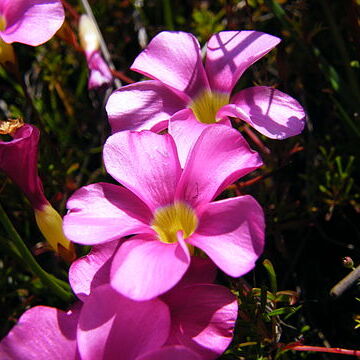Perennial herb with erect slender stems 5–30 cm high, 0.4–0.8 mm wide, minutely pubescent; bulb ovoid, acute, 5–9 mm long, tunics smooth, dark brown; bulbils subterranean, formed on slender, delicate rhizomes. Indumentum of simple eglandular hairs (rarely glandular on sepals). Stipules tapering into petiole. Leaves cauline or usually terminally congested, palmately trifoliolate; petiole 4–22 mm long, as long as leaves or exceeding leaves; leaflets sessile, linear, oblong or cuneate, 5–15 mm long, 1.3–2 mm wide, emarginate, often conduplicate, margins ciliate, the lamina bright green or slightly grey green, glabrous, with rather large blister-like epidermal cells above, and finely papillose below with or without 2 minute apical calli. Inflorescences terminal or axillary, 1-flowered; peduncles 20–100 mm long, longer than leaves. Bracts situated near or imbricating the calyx, linear-subulate or apex obtuse, 2–3.5 mm long, with scattered ascending, antrorse hairs, with 2 calli near apex. Sepals lanceolate or linear-lanceolate, 5–9 mm long, glabrous, rarely glandular ciliate, sometimes indistinctly bicallose at the apex. Petals obovate, 15–30 mm long, bright pink, yellow at base, glabrous. Stamens at 2 levels; filaments: the longer set sparsely glandular-pilose. Ovary pilose on the upper half or near the apex. Styles pubescent. Capsules not developed in Australia.
Caulescent geophyte with stem partly leafy, 5-20 cm, conspicuously stoloniferous and forming carpets. Leaves mostly terminal, trifoliolate, leaflets linear-cuneate. Flowers with long, narrow sepals, red, pink or white with yellow tube.

